Produced by: LD Capital Research
Produced by: LD Capital Research
secondary title
Summary
Summary
The metaverse originated from the Internet, but it is bound to grow into a more magnificent and charming world, but it is still too early;
The development of hard technology has become the biggest bottleneck in the development of Metaverse, followed by the heterogeneous integration of blockchain and the Internet. The above two points will lead to a significant decline in user experience, and it is difficult to form a virtuous circle of "network effect" and "flywheel effect";
Gamification, entertainment and economy will be the indispensable development direction of Metaverse. However, this development trend does not always bring good results, it will also make deprivation easier and more hidden, blockchain may be our only solution;
Be wary of the false bubbles of NFT assets and beware of stepping into a liquidity trap. Although NFT is popular all over the world, it is also easy to become a pure seller's market, and it is easy to be manipulated by less funds. Once the market consensus collapses, the price of NFT assets is prone to a cliff-like decline until liquidity is exhausted;
Introduction
Introduction
In 2021, with the listing of the first Roblox in the industry, the concept of "metaverse/metaverse" suddenly emerged, and "metaverse+" became a new trend sweeping the Internet, VR/AR and financial investment circles. , mankind seems to have opened the "interstellar navigation era" of the virtual universe.
In 2021, with the listing of the first Roblox in the industry, the concept of "metaverse/metaverse" suddenly emerged, and "metaverse+" became a new trend sweeping the Internet, VR/AR and financial investment circles. , mankind seems to have opened the "interstellar navigation era" of the virtual universe.
All this stems from both the helplessness of reality and the desire to explore in human nature. Throughout human history, the desire to explore has always been the driving force behind human progress, no matter in the "age of great geographical discovery" or "the era of technological explosion". Driven by the desire to explore, human beings crossed the barriers of the ocean and completely conquered the entire earth, and then embarked on an ambitious journey to the sea of stars, successively landed on the moon and launched probes outside the solar system.
The purpose of this article is to systematically and comprehensively summarize and analyze the past and present of the Metaverse, with a view to showing readers a panorama of the industry of the Metaverse, and will try to describe to readers the exciting future imagination based on the Metaverse. At the same time, based on the perspective of the development of the blockchain industry, this article will conduct detailed research and reasoning on the integration of DeFi, NFT and metaverse.
Ready Player One, Steven Spielberg
The Origin and Evolution of the Metaverse
"The Metaverse is a collective virtual shared space that includes all virtual worlds and the Internet combined, including but not limited to derivatives or copies of the real world, but is not equivalent to augmented reality. The term is often used to describe future iterations of the Internet The version refers to the perceivable virtual universe formed by the interconnection of many 3D virtual spaces that are persistently shared.”
The word Metaverse is derived from the combination of "meta" (beyond) and "verse" (universe), meaning "a universe beyond reality". The concept of metaverse (Metaverse) originated from the bold idea of science fiction writers. It was first proposed by science fiction writer Neal Stephenson in his science fiction novel "Snow Crash" in 1992. A fantastical cyberpunk world where you interact with software agents or other people's avatars. According to Wikipedia, its precise definition is as follows:
"The Metaverse is a collective virtual shared space that includes all virtual worlds and the Internet combined, including but not limited to derivatives or copies of the real world, but is not equivalent to augmented reality. The term is often used to describe future iterations of the Internet The version refers to the perceivable virtual universe formed by the interconnection of many 3D virtual spaces that are persistently shared.”
Snow Crash novel cover
From the definition of Metaverse, we can use "first principles" to simply summarize its main core features as:
From the definition of Metaverse, we can use "first principles" to simply summarize its main core features as:
sustainability
Metaverse is not just a VR movie or a UGC game, but should be a sustainable system that can continuously provide services and content, and the ecology is constantly developing and enriching, just like the Internet;
Metaverse aims to build a virtual shared space that transcends the real universe. Therefore, Metaverse must be combined with technologies such as VR, AR, and even brain-computer interfaces to have basic holographic sharing, 3D virtuality, low latency, real body sensation, and real-time interaction. and virtual identity, so as to provide users with a sensory experience that is real enough but beyond the real world;
openness
The metaverse should inherit the openness of the Internet, allowing anyone to freely access and leave the metaverse, and also encourage everyone to create and socially interact in the metaverse, so as to be able to broadly absorb technological innovations, financial innovations, and business models. All progress, including innovation and high-quality content, to achieve sustainable prosperity of the ecology;
economic system
The economic system of the Metaverse is the real finishing touch. Only fair, free and dynamic economic rules can encourage users to innovate continuously and accumulate high-quality content, thus providing a steady stream of nourishment for the prosperity of the Metaverse. It should consist of two parts: first, it supports an open payment and clearing system based on the blockchain to solve the real-time, fair, transparent, and fast P2P payment needs of users in the metaverse world; second, users in the metaverse The virtual items or innovations of the platform should be able to be marked and converted into digital assets, and support transactions, transfers, investments, etc., to encourage users to accumulate wealth through continuous innovation.
1.2 Evolution of the Metaverse
The metaverse is not a conjecture that came out of thin air, but a reasonable imagination based on the level of technological development and the laws of technological evolution. In order to sort out the industrial ecology and future development laws of the metaverse more realistically and accurately, it is necessary to understand the historical evolution of the metaverse Path is also an essential basic course.
The Internet is an important prerequisite for the birth of the Metaverse. It not only provides a material network foundation integrating network and computing power, but also produces a large number of original high-quality content (such as games, audio, video, etc.), thus actually forming the Metaverse. Infrastructure for virtual interconnection. The Metaverse is the inheritance and development of the Internet, and it is the future iteration of the Internet.
Internet: Infrastructure for Virtual Interconnection
The Internet is an important prerequisite for the birth of the Metaverse. It not only provides a material network foundation integrating network and computing power, but also produces a large number of original high-quality content (such as games, audio, video, etc.), thus actually forming the Metaverse. Infrastructure for virtual interconnection. The Metaverse is the inheritance and development of the Internet, and it is the future iteration of the Internet.
The development of the Internet can be traced back to ARPANET in 1969, which is mainly used for data exchange between research institutions. However, it was not until the birth of the World Wide Web in 1989 that the Internet really came into the public eye through the combination of the World Wide Web and web browsers, and quickly penetrated into people's social, work, life and entertainment. Although the Internet experience at that time was very general, it has already shown an unstoppable momentum of prosperity. For the first time, the Internet allows people all over the world to communicate and interact across regions and time zones through a virtual network. Therefore, after the birth of the concept of "Metaverse" in 1992, it has become an indispensable part of it.
Internet Visualization Atlas (2003), data source: the Opte Project
text
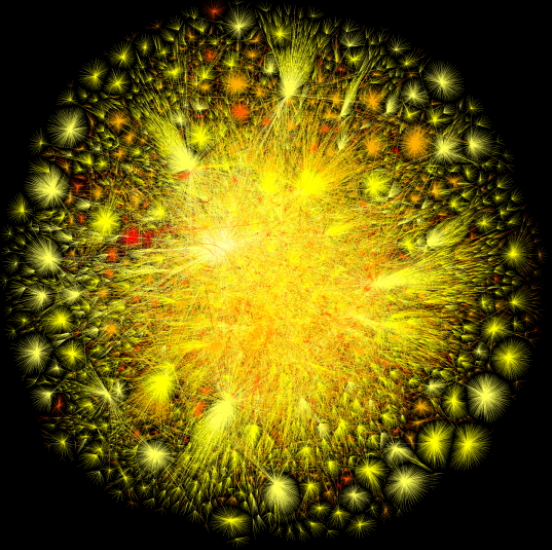
Today, with the miniaturization and mobility of general-purpose computers and the maturity of high-speed network technology represented by 5G, the Internet has been thoroughly integrated into all aspects of human society through terminals such as computers, mobile phones, tablet devices, and smart wearable devices. , and build an important material foundation for the era of globalization of human society. People can use the Internet to meet almost all living, social and entertainment needs, including work, social interaction, entertainment, catering, shopping, travel, etc. At the same time, a large number of online interactions of people will deposit a large amount of original content (UGC content). Further attract offline activities to shift online. At the same time, with the ravages of the new crown epidemic around the world, a large number of offline activities have shifted to online, and the "flywheel effect" and "network effect" have become more prominent. Human beings all over the world are accelerating into the era of virtual interconnection of networking and virtualization.
Today, with the miniaturization and mobility of general-purpose computers and the maturity of high-speed network technology represented by 5G, the Internet has been thoroughly integrated into all aspects of human society through terminals such as computers, mobile phones, tablet devices, and smart wearable devices. , and build an important material foundation for the era of globalization of human society. People can use the Internet to meet almost all living, social and entertainment needs, including work, social interaction, entertainment, catering, shopping, travel, etc. At the same time, a large number of online interactions of people will deposit a large amount of original content (UGC content). Further attract offline activities to shift online. At the same time, with the ravages of the new crown epidemic around the world, a large number of offline activities have shifted to online, and the "flywheel effect" and "network effect" have become more prominent. Human beings all over the world are accelerating into the era of virtual interconnection of networking and virtualization.
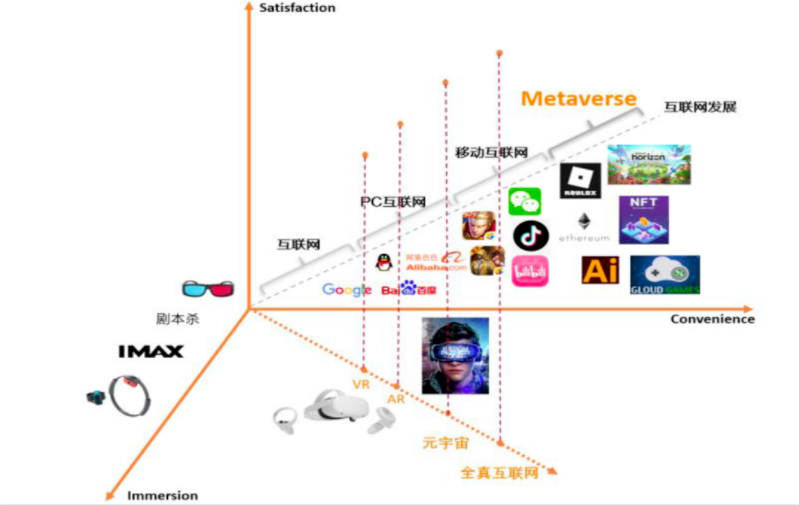
VR technology, the full name of Virtual Reality, refers to a computer simulation technology that creates and experiences virtual worlds; while AR technology, the full name of Augmented Reality, refers to a technology that ingeniously integrates virtual information and the real world to achieve a surreal sensory experience. . Obviously, both VR and AR technologies can become important technical components of the Metaverse, and related equipment can provide immersive or surreal interactive experiences for Metaverse players.
VR, AR and Brain-Computer Interface: Immersive Interactive Experience
The metaverse is not consistent with the ideal heaven or paradise in traditional religions, and it is also different from the "Neuromancer" that often appears in science fiction. Instead, it aims to build a persistent virtual shared space while still maintaining a sense of reality perception and experience of the world. Because of this, the development of the metaverse not only needs to realize the virtual interconnection of players, but also needs to allow players to obtain a real virtual experience, that is, to provide players with a realistic and immersive interactive experience to the maximum extent, and at the same time to allow players Maintain a perception of the real world. Therefore, the construction of the metaverse also requires immersive devices based on VR, AR and brain-computer interface technology as a necessary means of interaction.
VR technology, the full name of Virtual Reality, refers to a computer simulation technology that creates and experiences virtual worlds; while AR technology, the full name of Augmented Reality, refers to a technology that ingeniously integrates virtual information and the real world to achieve a surreal sensory experience. . Obviously, both VR and AR technologies can become important technical components of the Metaverse, and related equipment can provide immersive or surreal interactive experiences for Metaverse players.
Although VR/AR technology can be traced back to the 1950s and 1960s, its key equipment can only stay in the proof-of-concept stage for a long time. It was not until 2012 that the head-mounted VR device Oculus and the AR device Google Glass were launched successively, which made these two technologies truly enter the public eye. In addition, although brain-computer interface technology is still in the stage of laboratory research and development, it has the most imaginative application prospects.
The value of the blockchain in the metaverse is mainly reflected in the following three aspects:
Blockchain technology originated from Bitcoin, and its design prototype is a peer-to-peer electronic cash system, from which the underlying blockchain technology is derived: a decentralized distributed ledger technology based on P2P network, its basic characteristics Including not easy to tamper, open and transparent, P2P payment, etc. In the metaverse, the economic system will be the key to its large-scale and long-lasting operation, and blockchain technology will provide the metaverse with payment that seamlessly fits with the network virtual space due to its natural "decentralized value transfer" feature and clearing system.
smart contract
smart contract
NFT
secondary title
Oculus Rift headset, data source: Kickstarter
text
Blockchain: an open and transparent economic system
The blockchain-based economic system can provide the metaverse with financial services including network payment, value transfer and value storage, such as: providing users in the metaverse with the marking, confirmation and verification of virtual assets, virtual data and virtual rights and interests. trade. In addition, a fair, transparent and efficient economic system is also conducive to improving the efficiency of large-scale collaboration among players in the Metaverse.
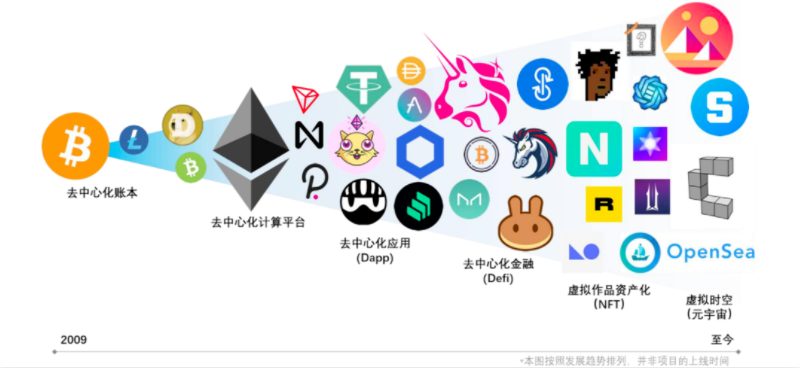
image description
The evolution of blockchain, data source: Guosheng Securities Research Institute
The Industrial Ecology of Metaverse
As of now, it will take some time for the Internet to evolve into the final Metaverse form, but as one of the major development directions of the Internet in the future, it is still full of imagination and attraction. Therefore, the leading companies and institutions in the world have already made arrangements in all aspects of the metaverse industry, hoping to get a pass to the next stop of the Internet. The following chapters will comprehensively sort out the industrial ecology of the three major directions of the Metaverse, the hardware industry, the content industry, and the blockchain.
The general hardware foundation of Metaverse mainly refers to computing power and network transmission. Among them, network transmission mainly ensures low latency of user interaction in order to obtain a more realistic somatosensory experience. The latest technological progress is the high-speed and low-latency network represented by 5G Transmission technology; and in terms of computing power, the computing power required by Metaverse is almost unlimited, which puts forward higher standards for personal terminals in terms of portability, high performance, and parallelization. Therefore, cloud computing technology has been widely valued because of its stronger scalability of computing power and its ability to effectively utilize computing power clusters and edge computing resources, thereby lowering the threshold of computing power for personal terminals. At present, cloud computing has been applied in the field of cloud games to a certain extent, and it is expected to become a powerful computing power support for the Metaverse industry in the future.
In the immersion requirements of the Metaverse, users must obtain real-time real-time physical sensations through interactive devices, which puts forward extremely stringent requirements for hardware. Therefore, hardware is an inevitable requirement for moving towards the Metaverse. Hardware can be divided into general-purpose hardware foundation and special-purpose hardware foundation. General-purpose hardware mainly includes computing power and transmission network, while special-purpose equipment mainly includes VR and AR equipment.
General hardware base
The general hardware foundation of Metaverse mainly refers to computing power and network transmission. Among them, network transmission mainly ensures low latency of user interaction in order to obtain a more realistic somatosensory experience. The latest technological progress is the high-speed and low-latency network represented by 5G Transmission technology; and in terms of computing power, the computing power required by Metaverse is almost unlimited, which puts forward higher standards for personal terminals in terms of portability, high performance, and parallelization. Therefore, cloud computing technology has been widely valued because of its stronger scalability of computing power and its ability to effectively utilize computing power clusters and edge computing resources, thereby lowering the threshold of computing power for personal terminals. At present, cloud computing has been applied in the field of cloud games to a certain extent, and it is expected to become a powerful computing power support for the Metaverse industry in the future.
text
Minecraft
Roblox
text
The innovation of the blockchain economic system lies in:
Absolute protection of rights and interests
It truly empowers creators with many core rights monopolized by platform organizations (such as virtual asset ownership, use rights, and disposal rights, etc.), and at the same time ensures the absolute fairness and transparency of related rights and interests through decentralized distributed ledger technology. This kind of technology (such as NFT) enables users to obtain rights protection similar to the real physical world in the virtual space of the metaverse, and the assets owned by users can be freely circulated, traded and disposed without being restricted by other third parties. In addition, the programmatic contract based on smart contracts can not only provide users with fair and transparent protection of rights and interests, but also realize the automation of distribution of rights and interests without trust guarantees, thereby greatly reducing the hidden costs of confirmation and liquidation of various economic activities;
Complete Financial Services
An open financial ecosystem based on blockchain (such as DeFi) can provide a series of efficient, fair, and transparent financial services for various virtual assets in the Metaverse, including asset issuance, asset auction, asset mortgage lending, and insurance. This complete financial service system will further consolidate the real attributes of virtual items, reduce the cost of economic activities and related content creation, and thus increase the enthusiasm of all parties involved in the Metaverse;
In the Internet, virtual assets are actually controlled by mutually independent institutional platforms. Therefore, if cross-platform virtual asset circulation is to be realized, mutual credit and data sharing between platforms must first be realized. The process is complicated and the transfer time is long , High circulation costs. However, virtual assets on the blockchain (including data, works of art, and digital identities, etc.) can realize cross-platform free circulation and peer-to-peer transactions on the basis of the same underlying public chain. With the maturity and application of blockchain cross-chain technology and Layer 2 technology, the low-cost free circulation of any blockchain assets will be realized.
text
DeFi and NFTs
GameFi
The dedicated hardware foundation related to the Metaverse mainly refers to related equipment that ensures the user's real interaction and immersion, including AR equipment, VR equipment, and brain-computer interface equipment. Among them, VR and AR devices are relatively mature and can already be applied to some commercial scenarios, such as 3D movies, 3D concerts, simulated driving training, online virtual tourism, etc.
At present, the high-speed network industry represented by 5G has entered large-scale commercial use, and has become a must for the telecommunications industry of various countries. China began to promote 5G commercial use in 2019, and began to significantly speed up construction in 2020. At present, it has built more than 800,000 5G base stations, accounting for about 70% of the global proportion. 5G-related companies mainly include Huawei, Nokia, ZTE, Samsung, Ericsson and Qualcomm.
Dedicated hardware foundation
The dedicated hardware foundation related to the Metaverse mainly refers to related equipment that ensures the user's real interaction and immersion, including AR equipment, VR equipment, and brain-computer interface equipment. Among them, VR and AR devices are relatively mature and can already be applied to some commercial scenarios, such as 3D movies, 3D concerts, simulated driving training, online virtual tourism, etc.
However, VR and AR devices are still far from reaching a fully mature stage, and are unable to provide users with smooth, stable, long-lasting and virtual shared large-scale interaction and sharing experience. The reason is that VR and AR terminals are not only complicated and heavy, but also can only give people a super-realistic experience of local senses, and cannot realize the sharing and interaction of all senses. Brain-Computer Interface (BCI) technology also stands out.
However, VR and AR devices are still far from reaching a fully mature stage, and are unable to provide users with smooth, stable, long-lasting and virtual shared large-scale interaction and sharing experience. The reason is that VR and AR terminals are not only complicated and heavy, but also can only give people a super-realistic experience of local senses, and cannot realize the sharing and interaction of all senses. Brain-Computer Interface (BCI) technology also stands out.
Brain-computer interface technology refers to the establishment of a direct signal channel between the human brain and other electronic devices, thereby bypassing language and body to achieve interaction with electronic devices. Since all human senses are ultimately formed by transmitting signals to the brain, if the brain-computer interface technology is used, in principle, it will be possible to completely simulate all sensory experiences by stimulating the corresponding areas of the brain.
In principle, compared with VR and AR devices, the brain-computer interface directly connected to the human cerebral cortex is more likely to become the best device for interaction between players and the virtual world in the future metaverse era. At that time, people will not need to go on an interstellar voyage, but they will be able to experience the magnificent and magical world in the virtual "Avatar" world through the brain-computer interface. At present, the brain-computer interface technology is still in the experimental stage, and the main deployment companies include Elon Musk's NeuraLink, Kernel, Mindmaze, etc.
Still from Avatar, James Cameron
In the Internet age, "flywheel effect" and "network effect" are two important laws that drive the continuous prosperity and development of the entire industry. Similarly, these two laws are also applicable to the industrial development of the Metaverse. That is, the content industry in the metaverse needs to be attractive enough in terms of category and quality to form a "network effect" and reduce the marginal cost of scale expansion; when it develops to a stage where the ecology is sound and prosperous enough, a "flywheel effect" will be formed, Enter the stage of continuous prosperity of ecological self-promotion and high-quality content self-proliferation. At present, many Internet companies are actively deploying the content industry of the Metaverse, such as Valve Steam developed around the content of the Metaverse, Facebook's oculus & Horizon platform, Nvidia's Omniverse, and Code Universe's interactive physics engine.
Generally speaking, to form a healthy virtual world, at least the basic needs of people in reality, such as entertainment, social interaction, and work, must be met. And because the Metaverse has incomparable advantages in terms of immersion and interactivity, virtual games that focus on user experience will become the breaking point of the Metaverse, and will most likely become the focus of social and work scenes in the Metaverse. main carrier.
It can be said that the metaverse will become the best carrier for virtual games, and virtual games will also become the main content display form for most scene applications in the metaverse (such as art, entertainment, and even some life scenes, etc.). That is, all application scenarios in the metaverse will show obvious gamification features. Obviously, open UGC games represented by Minecraft and Roblox have already begun similar explorations.
Minecraft is a famous sandbox game whose first public version was released in 2009. The game offers players nearly unlimited creative freedom, with an emphasis on letting players explore, interact, and create on their own. Players can use the material blocks and environment monomers provided by the game to perform various activities including map transformation, building construction, ore collection, combat adventures, etc.
The popularity of Minecraft is inseparable from the UGC model. Through the supporting toolkit, the threshold for players to develop games is lowered, the cost of content creation is reduced, and the individual needs of players can be well met, thereby greatly improving users' creativity and stickiness. . It is reported that Minecraft has more than 400 million registered users, 12,000 development teams and more than 55,000 high-quality content.
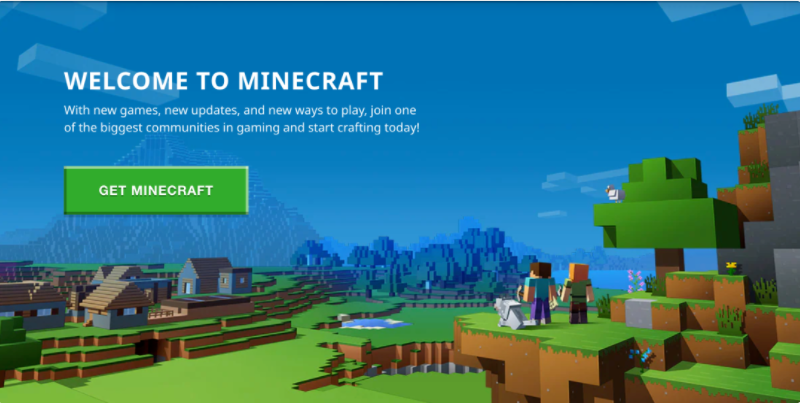
By the end of 2020, Roblox has an average of 32.6 million daily active users, 8 million active developers on the platform, and millions of 3D game experiences. In 2019, the MAU of Roblox’s community players exceeded 100 million, and more than 10 million creators used Roblox to create. By Q1 of 2021, the platform has more than 18 million game experiences, and the DAU is as high as 42.1 million. 7 million developers. At present, Roblox has been listed, and its market value exceeded 40 billion U.S. dollars on the day of its launch, making it a well-deserved "first stock in the Metaverse".
Founded in 2004, Roblox has made a lot of innovations on the basis of sandbox games. It not only provides users with richer and more comprehensive material libraries, editing functions and creative content, but also is compatible with VR game creation and provides development-oriented The author's Reblox Studio and Roblox Cloud, a point-and-play game cloud platform. More importantly, Roblox also provides economic incentives for players by introducing virtual tokens in addition to content creation incentives.
By the end of 2020, Roblox has an average of 32.6 million daily active users, 8 million active developers on the platform, and millions of 3D game experiences. In 2019, the MAU of Roblox’s community players exceeded 100 million, and more than 10 million creators used Roblox to create. By Q1 of 2021, the platform has more than 18 million game experiences, and the DAU is as high as 42.1 million. 7 million developers. At present, Roblox has been listed, and its market value exceeded 40 billion U.S. dollars on the day of its launch, making it a well-deserved "first stock in the Metaverse".
image description
All in all, the content industry in the metaverse will be very different from the Internet era, and will be displayed through games as the main body, such as typical games + concerts, games + work meetings, games + graduation ceremonies, etc. For example, on February 3, 2021, American rapper Travis Scott held a virtual event called "ASTRONOMICAL" on the virtual stage built in the game "Fortnite" in the form of holographic character projection through motion capture technology. The concert attracted more than 10.7 million spectators in just 10 minutes. With the advent of the metaverse era, new entertainment, new social and even new collaboration modes will emerge by combining other needs with virtual games.
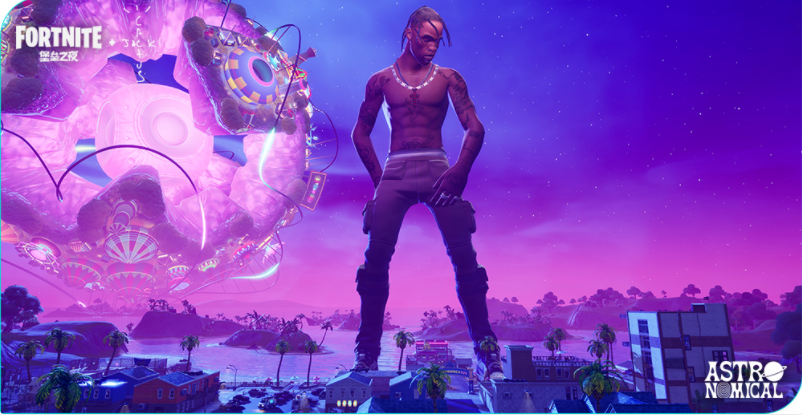
Travis Scott's virtual concert in "Fortress Night", data source: Travis Scott & "Fortress Night"
2.3 Blockchain industry
Taking Roblox as an example, one of the very important reasons why it became the "first stock in the Metaverse" is that they provided the original "Play to Earn" economic incentive model, which made the game add more than pure entertainment and social attributes. According to the profit expectation, its economic system is shown in the figure below. However, there is still a lot of room for improvement in this economic system. For example, it is difficult for players to directly auction and realize their excellent virtual assets, and the right to interpret the created virtual assets (including the interpretation of ownership and usufruct rights) It does not belong to the player, but to the platform organization. In addition, private data such as the user's personally identifiable information is also held by the platform organization. This monopoly of actual control over virtual assets is a great hindrance to the development and prosperity of the metaverse, which prevents it from maximizing the creativity of players. And the solution to all this lies in the blockchain economic system.
image description
Roblox economic system, data source: Roblox and Tianfeng Securities Research Institute
Blockchain technology originated from Bitcoin technology and flourished on the smart contract platform Ethereum. At present, a very comprehensive ecosystem has been formed, such as computing, privacy protection, distributed storage, finance, games, etc. Among them, the open finance marked by DeFi and the game marked by GameFi are not only the most mature and imaginative track at present, but also an indispensable and important part of the coming metaverse in the future.
So far, according to the statistics of the blockchain data tracking website DeFi Pulse, in the entire blockchain industry, DeFi has accumulated a huge amount of liquidity on the chain, and its overall lock-up value is as high as 8.11 billion US dollars. The business scope of DeFi and The products are also becoming more and more perfect and mature, covering various financial businesses such as decentralized exchanges, lending, payment, derivatives, asset management, and insurance. Typical projects include Aave, Compound, Uniswap, and Maker. Among them, Uniswap has become the first DeFi agreement in history with a total revenue exceeding US$1 billion.
DeFi provides an open finance that fits the characteristics of the free sharing of the metaverse, and can provide financial services including transactions, loans, and insurance to help reduce the creation cost and realization cost of works for metaverse players.
So far, according to the statistics of the blockchain data tracking website DeFi Pulse, in the entire blockchain industry, DeFi has accumulated a huge amount of liquidity on the chain, and its overall lock-up value is as high as 8.11 billion US dollars. The business scope of DeFi and The products are also becoming more and more perfect and mature, covering various financial businesses such as decentralized exchanges, lending, payment, derivatives, asset management, and insurance. Typical projects include Aave, Compound, Uniswap, and Maker. Among them, Uniswap has become the first DeFi agreement in history with a total revenue exceeding US$1 billion.
As a "non-homogeneous pass", NFT is a middleware between the application layer and the blockchain public chain. It mainly provides various virtual assets (including data and works, etc.) The rights and interests record and absolute control rights allow users to issue, store, mortgage and transfer virtual assets in a fair, transparent and safe manner. At present, NFT has been widely used in the marking and trading of virtual assets and virtual rights in various fields. According to the statistics of NonFungible.com, the highest weekly sales of NFT in the whole network exceeds 375 million US dollars.
As a "non-homogeneous pass", NFT is a middleware between the application layer and the blockchain public chain. It mainly provides various virtual assets (including data and works, etc.) The rights and interests record and absolute control rights allow users to issue, store, mortgage and transfer virtual assets in a fair, transparent and safe manner. At present, NFT has been widely used in the marking and trading of virtual assets and virtual rights in various fields. According to the statistics of NonFungible.com, the highest weekly sales of NFT in the whole network exceeds 375 million US dollars.
image description
Take Cryptopunks, the number one original cyberpunk art project, as an example. From 2017 to the present, its total transaction value has reached approximately US$650 million. Among them, "CryptoPunk #7804" and "CryptoPunk #3100" in March 2021 were sold for 4200 ETH (worth about 7.5 million US dollars). In Christie's New York's "21st Century Art Auction" on May 13, 2021, a group of nine PUNK heads were sold for another $14.5 million. On June 10, 2021, "CryptoPunk #7523" was sold at a sky-high price of 11.754 million US dollars. The gold-absorbing ability of NFT in the field of art is impressive. Suddenly, the NFT craze swept across entertainment, games, sports, social, luxury and other fields, such as Coca-Cola, Louis Vuitton, sports star Pele, fashion magazine Vogue, etc. into the game.
image description
pet raising games
pet raising games
The earliest explosive product of this type of blockchain game can be traced back to the pet development game launched by the Dapper Labs team in 2017: the encrypted cat game CryptoKitties. It was officially launched on November 28, 2017. By December 5, the game had accounted for about 25% of the total transaction volume on Ethereum, which once caused serious congestion on the Ethereum network.
The earliest explosive product of this type of blockchain game can be traced back to the pet development game launched by the Dapper Labs team in 2017: the encrypted cat game CryptoKitties. It was officially launched on November 28, 2017. By December 5, the game had accounted for about 25% of the total transaction volume on Ethereum, which once caused serious congestion on the Ethereum network.
Another pet-raising game, Axie Infinity, also created in 2017, has made more significant improvements in playability, user experience and economic model after continuous iterations from 2018 to 2020. The game internally uses the AXS and SLP dual-token economic model to split the fuel cost and equity income, and joins the combustion deflation mechanism, scholarship system, gold lease and other modes, which greatly improves the funds of the entire game Turnover. In April 2021, the game agreement revenue is only $670,000. Since migrating to the Ronin sidechain in May, protocol revenue has exploded, from $3 million in May to $12.2 million in June, and Axie protocol revenue reached $166.2 million in July. Within 3 months, the income of the game agreement has increased by 248 times, and at the same time, it has reached nearly 300,000 user wallet interactions within 30 days, which can be regarded as a model of "Play to Earn" comparable to Roblox.
Fan Economy Games
Fan Economy Games
In 2017, after the popularity of the CryptoKitties game exposed the performance problem of the poor scalability of the Ethereum network, its publisher, Dapper Labs, subsequently launched Flow, a public chain platform specially developed for blockchain games, and in 2020 Flow After the mainnet went live, the NBA and NBPA jointly launched a fan economic game: NBA Top Shot. The game focuses on the collection of sports stars' peripherals. The core gameplay is through the official card packs, and allows players to buy, sell and collect NBA officially authorized collections in the trading market (currently there are players' wonderful moments).
Top Shot launched the public beta in October 2020. It had only a few hundred users at the beginning, and reached nearly 20,000 active users in January 2021. At the same time, the total turnover surpassed CryptoKitties on January 26 and reached 29.48 million US dollars. And on February 22, 2021, the sales of 45.768 million US dollars were completed. As of today, its total transaction volume has reached 670 million US dollars.
NBA Top Shot poster, data source: NBA & NBA Top Shot
sandbox games
image description
In-game virtual assets of The Sandbox, data source: The Sandbox
In-game virtual assets of The Sandbox, data source: The Sandbox
With the continuous improvement and maturity of related industries such as VR/AR hardware, content and blockchain, "Metaverse" has quickly become popular in the capital circle due to its gradually unfolding broad prospects, and suddenly attracted the attention of a large number of investment institutions and entrepreneurs force.
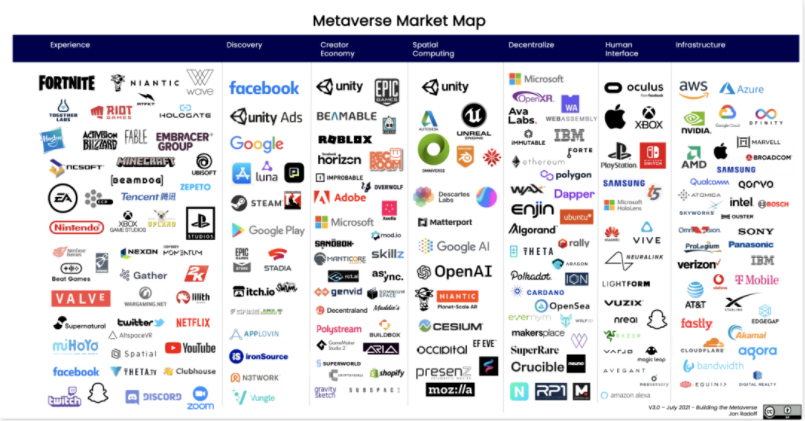
image description
Metaverse Market Map, Source: Jon Radoff
Chinese investment community
Since Roblox, the "first stock in the metaverse" listed in March 2021, had a market value exceeding US$40 billion on the first day of listing, the game company MetaApp subsequently completed a US$100 million C round called "the largest single financing in the domestic metaverse track". financing. In addition, Code Universe, known as the "Chinese version of Roblox", also quickly received a strategic investment of 100 million yuan from ByteDance. Almost at the same time, the game company Epic Games also easily obtained a new round of financing of 1 billion US dollars. This star enterprise that continues to lose money even received additional investment from Sony for the layout of the metaverse.
In the domestic investment circle, Tencent's layout is more forward-looking. As early as the end of 2020, Ma Huateng called out the prophecy of "Quanzhen Internet", invested in Roblox before its listing, and exclusively represented its product distribution in China. In addition, Tencent spent US$330 million to purchase a 40% stake in virtual game engine developer Epic Games, and invested in virtual concert operator Wave, photo and video social application Snapchat parent company Snap, and free expression tool Bitmoji, etc. industrial enterprises.
Overseas investment community
In the field of overseas equity investment, companies such as Facebook, Apple, Disney, Amazon, and Google have already begun to deploy the metaverse industry. In May 2020, Apple acquired the VR live streaming startup Next VR at a valuation of US$100 million, and in the following August, Apple acquired the VR technology startup Spaces, which mainly develops VR offline experience and VR video conferencing platform . Up to now, Apple has more than 330 publicly available VR/AR key patents, and 18 VR/AR related mergers and acquisitions.
However, the company with the most aggressive industrial layout in the metaverse belongs to Facebook. As early as 2014, Facebook acquired VR equipment manufacturer Oculus at a high price of US$2 billion, and increased its investment in VR business from US$5.9 billion per year to nearly US$18.5 billion. Its founder, Zuckerberg, firmly believes that: "Metaverse is the next Internet." It has invested tens of thousands of manpower in the company's VR/AR business, accounting for about ⅕ of the total number of employees. The metaverse product team.
Encryption investment community (overseas)
In the encryption investment world, some investment institutions are actually cross-border layouts of traditional equity investment institutions. Take the well-known investment fund Andreessen Horowitz (a16z) as an example. It was founded in 2009. It is not only an early investor in Roblox, but also actively participates in the development of virtual reality games such as Singularity 6, Sleeper, Sandbox VR, Bonfire; Facebook’s virtual reality Investments in a number of metaverse-related companies, including environmental technology company Oculus and VR fitness app Supernatural. In addition, a16z also actively participates in the investment in the blockchain industry through its encrypted investment fund, and its investment portfolio covers well-known blockchain projects such as Cryptokitties, Flow Network, Rally, and Opensea.
image description
Metaverse: A cyberpunk future within reach?
Metaverse: A cyberpunk future within reach?
By sorting out the entire development and evolution history of the Metaverse and the current industry status, we have drawn the following inferences:
By sorting out the entire development and evolution history of the Metaverse and the current industry status, we have drawn the following inferences:
The metaverse originated from the Internet, but it is bound to grow into a more magnificent and fascinating world, but it is still too early. The Metaverse may be one of the most beautiful and fascinating flowers that can ever grow on the big tree of the Internet. However, according to the review results of the development status of the entire industrial chain in this article, although the flowers of the Metaverse are beautiful and attractive, there is still a long distance from the fruit of the Metaverse in the final form we expect;
The development of hard technology has become the biggest bottleneck in the development of Metaverse, followed by the heterogeneous integration of blockchain and the Internet. So far, the content industry and the blockchain industry in the Metaverse have developed unexpectedly rapidly, but the current development of the Metaverse still cannot avoid the development of hard technologies including AI, VR/AR, high-speed networks, and brain-computer interfaces. bottlenecks in the field. In addition, the blockchain and the Internet are heterogeneous systems, and how to combine the huge user base of the Internet with the self-motivated economic rules of the blockchain is another problem that needs to be solved urgently. The above two points will lead to a significant decline in user experience, and it is difficult to form a virtuous circle of "network effect" and "flywheel effect";
Gamification, entertainment and economy will be the indispensable development direction of Metaverse. However, this development trend does not always bring good results, it will also make deprivation easier and more hidden, blockchain may be our only solution;
Be wary of the false bubbles of NFT assets and beware of stepping into a liquidity trap. Although NFT is popular all over the world, it is also easy to become a pure seller's market, and it is easy to be manipulated by less funds. Once the market consensus collapses, the price of NFT assets is prone to a cliff-like decline until liquidity is exhausted;
The development prospects of GameFi are worth looking forward to, but the abnormal turnover and profits of some projects may not be replicable.
references
Neal Stephenson, Snow Crash, 1992
“Metaverse”, Wikipedia
“The Internet 1991-2021”, the Opte Project
“Augmented, Mixed and Virtual Reality 2020-2030: Forecasts, Markets and Technologies”, IDTechEx Research
“The metaverse: what every early-stage investor needs to know”, Frank Holmes, 2021
“Dapp industry overview:July 2021”, DappRadar, 2021
references
"Metaverse: The Next Stop of the Internet", Guosheng Securities, 2021
disclaimer
“The NFTs ecosystem: 2021 boom & beyond”,Sasha Shilina & Paradigm, 2021
disclaimer
The information in this research report comes from publicly disclosed information, and the opinions in this article are for research purposes only and do not represent any investment opinions. The opinions and forecasts issued in the report are only the analysis and judgment of the date of issuance, and do not have permanent validity. In addition, in any case, the organization and the author shall not be liable for any loss caused by anyone using any content in this report.



